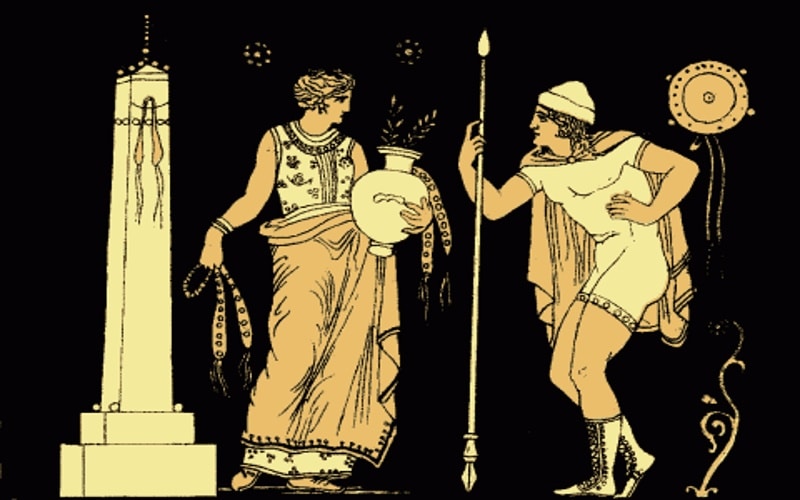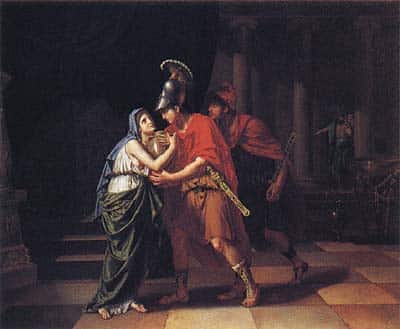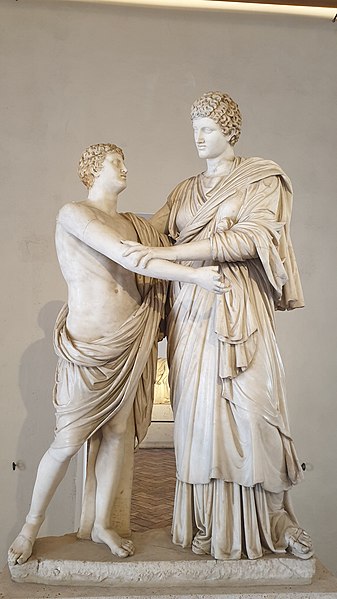Electra, a name that resonates with passion, revenge, and tragedy, is one of the most intriguing figures in Greek mythology. As the daughter of King Agamemnon and Queen Clytemnestra, her life was marked by a series of dramatic events that have inspired countless works of art, literature, and theater.
Electra Key Facts
| Parents | King Agamemnon and Queen Clytemnestra |
| Partners | Pylades |
| Siblings | Orestes, Iphigenia, and Chrysothemis |
| Offspring | None known |
| Other names | None significant |
| Roman name | Electra |
| Best Known Myth | Revenge against her mother for her father’s murder |
Name and Etymology
Electra, derived from the ancient Greek word “ēlektron,” means “amber.” This name, shimmering with a golden hue, reflects her radiant presence in the myths that surround her. In Roman mythology, she retains her Greek name, a testament to her unique and unforgettable character. Throughout various tales, she’s occasionally referred to by epithets that highlight her intense emotions and her quest for revenge, but “Electra” remains the most iconic and recognized name for this tragic heroine.
Electra’s Family and Relationships

Born to the mighty King Agamemnon and Queen Clytemnestra, Electra’s lineage was nothing short of royal. However, her family life was marred by betrayal and tragedy. Her father, Agamemnon, sacrificed her sister Iphigenia to appease the goddess Artemis, a decision that would set off a chain of tragic events. This act deeply affected Electra, forging a bond of grief and vengeance with her brother Orestes.
Electra’s childhood was overshadowed by her father’s death at the hands of her mother and her lover, Aegisthus. This treachery ignited a burning desire for revenge in Electra’s heart. While romantic relationships were not the focal point of her narrative, her bond with Pylades, Orestes’ close friend, is noteworthy. Their alliance played a pivotal role in her quest for vengeance.
Myths about Electra
Electra’s life, as portrayed in Greek myths, is a tapestry of tragedy, vengeance, and emotional upheavals. To truly understand her, we must delve deep into the myths that shaped her destiny.
Electra’s Exile
The tale begins with the backdrop of the Trojan War. Electra’s father, King Agamemnon, had angered the goddess Artemis. To appease her and ensure a safe voyage to Troy, he made the heart-wrenching decision to sacrifice his eldest daughter, Iphigenia. This act deeply scarred the family, especially Electra and her mother, Queen Clytemnestra.
While Agamemnon was away at war, Clytemnestra’s grief turned to rage. She took a lover, Aegisthus, and together they plotted Agamemnon’s murder. Upon the king’s return from Troy, they executed their plan, killing him in cold blood. Electra, devastated by her father’s death and repulsed by her mother’s actions, openly condemned the murderous duo. Her outspokenness led to her exile from the palace, a period marked by loneliness and a burning desire for revenge.
The Recognition Scene
Years passed, and Electra’s younger brother, Orestes, who had been sent away as a child for his safety, grew into a young man. Guided by the Oracle of Delphi and fueled by his own desire for vengeance, Orestes returned to Mycenae. However, so much time had passed that Electra did not recognize him upon their first encounter.
Their reunion is one of the most poignant moments in Greek tragedy. At first, they exchanged tales of their woes, with Electra lamenting the loss of her brother. It was only when Orestes revealed certain tokens—a lock of his hair, footprints, and an old robe—that Electra realized she was speaking to her long-lost sibling. Their reunion was bittersweet, filled with tears of joy and sorrow, and it solidified their resolve to avenge their father’s death.
The Revenge Plot
With their bond rekindled, Electra and Orestes began plotting their revenge. They knew the task wouldn’t be easy; after all, they were going against the reigning queen and her powerful lover. But their determination was unwavering.

Electra played a crucial role in the scheme, acting as the emotional anchor and driving force behind their actions. With the help of Pylades, Orestes’ close friend and confidant, the siblings devised a plan. They spread the false news of Orestes’ death, lulling Clytemnestra and Aegisthus into a false sense of security. Using this element of surprise, Orestes managed to kill Aegisthus.
The final confrontation was between Orestes and his mother. Electra, torn between her love for her mother and her desire for justice, stood by Orestes as he carried out the act, avenging their father’s death. This act of matricide, while bringing justice in Electra’s eyes, also brought forth a slew of moral dilemmas, questioning the very fabric of familial bonds and the price of vengeance.
Consequences for Electra
After the revenge, Electra’s fate varies depending on the source and the version of the myth. Here’s a brief overview:
- Sophocles’ “Electra”: In Sophocles’ version, after the revenge, Electra marries Pylades, Orestes’ close friend and confidant. This marriage is seen as a reward for her loyalty and dedication to avenging her father’s death. The play concludes with this union, symbolizing a new beginning for Electra after the tumultuous events of her past.
- Euripides’ “Electra”: Euripides paints a slightly different picture. In his version, after Clytemnestra’s death, Electra is married off to a peasant by Aegisthus as a form of punishment for her outspokenness against him and Clytemnestra. After the revenge, Orestes promises to find a more suitable husband for Electra, but she chooses to stay with her peasant husband, valuing his kindness and loyalty over social status.
- Aftermath of the Revenge: The act of matricide weighed heavily on Orestes. He was pursued by the Erinyes (Furies), ancient goddesses of vengeance, for killing his mother. Electra, though not pursued by the Furies as Orestes was, still had to grapple with the moral implications of their actions. In some versions, she lived the rest of her life in relative peace, while in others, she continued to be haunted by the decisions she made.
- Later References: Electra’s character and her story have been revisited in various forms of art and literature over the centuries. While ancient Greek plays and myths provide the primary sources of her life, later interpretations, including modern retellings, might offer alternative endings or insights into her life post-revenge.
Depiction And Characteristics
Electra’s portrayal in myths paints a picture of a woman consumed by grief and vengeance. Her fiery spirit and unwavering determination are her defining traits. Often depicted with a torch or a sword, symbols of her burning desire for revenge, she stands as a beacon of justice and retribution.
Animals or plants aren’t typically associated with Electra, but her character is deeply intertwined with themes of tragedy, loyalty, and revenge. Her actions, driven by intense emotions, showcase the complexities of human nature and the moral quandaries one faces when seeking justice.
Representations Of Electra In Art
Electra’s tragic tale has inspired countless artists over the centuries. One of the most iconic depictions is in the sculptures of the classical era, where she’s often portrayed alongside Orestes, emphasizing their shared quest for vengeance.

In paintings, her expressive eyes and intense demeanor capture the essence of her character. The raw emotions of grief, anger, and determination are palpable in these artistic renditions. Moreover, the theater has been a significant medium for her story, with plays by Sophocles and Euripides delving deep into her psyche and the moral dilemmas she grapples with.
Mentions in Ancient Texts
Electra’s compelling narrative has been a muse for countless ancient writers, each offering their unique perspective on her tale. Let’s delve into some of the most influential mentions of her story in classical literature.
“Electra” by Sophocles
Around 409 BC, the renowned tragedian Sophocles presented his version of Electra’s story. Sophocles, one of the three ancient Greek playwrights whose works have stood the test of time, was known for his innovations in drama. In his rendition, he poignantly states, “For there is no mother anywhere who could pray to the gods in all honesty that her sons turn out like Orestes.”
“Electra” by Euripides
Euripides, another titan of Greek tragedy, penned his interpretation of Electra’s tale circa 413-412 BC. His portrayal of mythological figures as ordinary individuals in extraordinary circumstances set him apart. From his play, a resonating line reads, “The bond that links your true family is not one of blood, but of respect and joy in each other’s life.”
“Oresteia” by Aeschylus
Aeschylus, often described as the father of tragedy, crafted the “Oresteia” in 458 BC. This trilogy, focusing on the tumultuous House of Atreus, offers a profound insight into Electra’s world. Aeschylus captures the essence of the cycle of revenge with the words, “Blood will have blood; and the air, the air is full of it.”
“Libation Bearers” by Aeschylus
Returning to Aeschylus, the “Libation Bearers,” written in 458 BC, is the second play in his Oresteia trilogy. This piece, focusing on the revenge of Orestes and Electra, offers a haunting reflection on their actions: “The doer suffers.”
Frequently Asked Questions
Electra was the daughter of King Agamemnon and Queen Clytemnestra.
She sought revenge for the murder of her father by her mother and her lover, Aegisthus.
Yes, she had siblings named Orestes, Iphigenia, and Chrysothemis.
Electra is often depicted with symbols of revenge, like torches or swords, and is a central figure in many classical plays.
While her tales primarily focus on revenge, her bond with Pylades, a close friend of Orestes, is noteworthy.
After avenging her father’s death, Electra’s tale varies; some versions depict her living in peace, while others delve into the moral consequences of her actions.
Featured Image Credit: Unknown author, Public domain, via Wikimedia Commons
